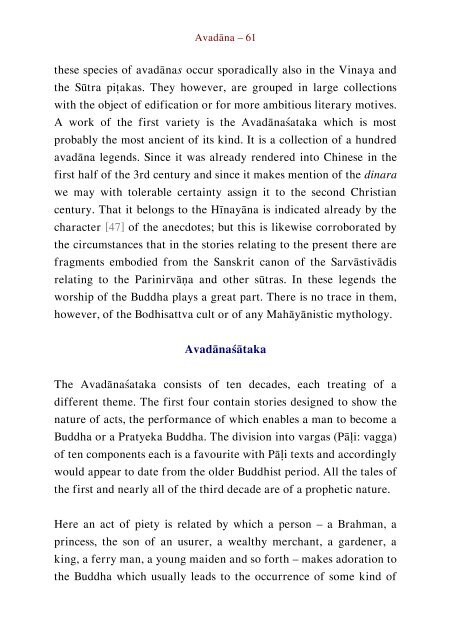Literary History of Sanskrit Buddhism
A study by J. K. Nariman of Sanskrit Buddhism from the Early Buddhist Tradition up to the Mahayana texts proper.
A study by J. K. Nariman of Sanskrit Buddhism from the Early Buddhist Tradition up to the Mahayana texts proper.
Create successful ePaper yourself
Turn your PDF publications into a flip-book with our unique Google optimized e-Paper software.
Avadāna – 61<br />
these species <strong>of</strong> avadānas occur sporadically also in the Vinaya and<br />
the Sūtra piṭakas. They however, are grouped in large collections<br />
with the object <strong>of</strong> edification or for more ambitious literary motives.<br />
A work <strong>of</strong> the first variety is the Avadānaśataka which is most<br />
probably the most ancient <strong>of</strong> its kind. It is a collection <strong>of</strong> a hundred<br />
avadāna legends. Since it was already rendered into Chinese in the<br />
first half <strong>of</strong> the 3rd century and since it makes mention <strong>of</strong> the dinara<br />
we may with tolerable certainty assign it to the second Christian<br />
century. That it belongs to the Hīnayāna is indicated already by the<br />
character [47] <strong>of</strong> the anecdotes; but this is likewise corroborated by<br />
the circumstances that in the stories relating to the present there are<br />
fragments embodied from the <strong>Sanskrit</strong> canon <strong>of</strong> the Sarvāstivādis<br />
relating to the Parinirvāṇa and other sūtras. In these legends the<br />
worship <strong>of</strong> the Buddha plays a great part. There is no trace in them,<br />
however, <strong>of</strong> the Bodhisattva cult or <strong>of</strong> any Mahāyānistic mythology.<br />
Avadānaśātaka<br />
The Avadānaśataka consists <strong>of</strong> ten decades, each treating <strong>of</strong> a<br />
different theme. The first four contain stories designed to show the<br />
nature <strong>of</strong> acts, the performance <strong>of</strong> which enables a man to become a<br />
Buddha or a Pratyeka Buddha. The division into vargas (Pāḷi: vagga)<br />
<strong>of</strong> ten components each is a favourite with Pāḷi texts and accordingly<br />
would appear to date from the older Buddhist period. All the tales <strong>of</strong><br />
the first and nearly all <strong>of</strong> the third decade are <strong>of</strong> a prophetic nature.<br />
Here an act <strong>of</strong> piety is related by which a person – a Brahman, a<br />
princess, the son <strong>of</strong> an usurer, a wealthy merchant, a gardener, a<br />
king, a ferry man, a young maiden and so forth – makes adoration to<br />
the Buddha which usually leads to the occurrence <strong>of</strong> some kind <strong>of</strong>


















